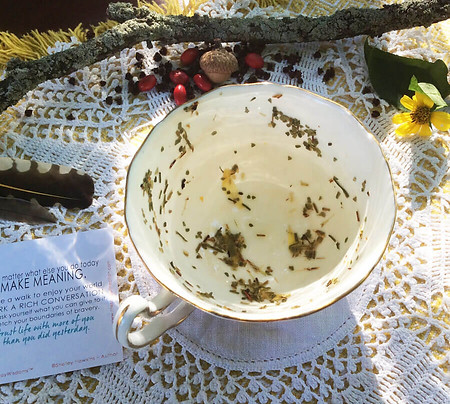

TASSEOMANCY
One of the most common methods of Divination is Tasseomancy, also known as Tasseography and more commonly known as tea leaf reading. This method originated in the medieval period and starts with simply brewing a cup of tea!
In order for tea leaves to be read, they must be loose, and a wide, shallow cup is suggested. This allows the tea leaves to spread out and form symbols. The reader pours water into the cup normally, but while the tea is steeping, the reader should hold the cup and consider the question that he/she intends to ask. The tea cup should be held in the opposite hand from normal, which helps to arouse the divinatory energies, and then the reader drinks the tea.
When the liquid is nearly gone, the reader shakes and swirls the cup around, allowing the tea leaves to settle. Each seer has his/her own method of shaking the cup; some will swirl until it feels right, others choose to stick with the number three, and many choose to swirl clockwise rather than counter-clockwise. Some seers tip the tea leaves onto the saucer, while others read them right inside the cup. It is suggested that you try a variety of methods to determine which works best for you.
Looking at the tea leaves, you’ll generally need to relax your focus and relax your eyes so that images begin to appear among them. Sometimes just one image will appear, while other cups will yield multiple smaller images. With multiple images, the reader traditionally starts at the handle and rotates clockwise to interpret them. However, when completing a reading for someone else, some seers point the cup’s handle at the Querent, interpreting the images to the left of the handle as representing the past and those to the right to the future.
Now, once you find an image, how will you know what it means? The more practice you get with Divination, the more familiar you’ll be with the various symbols that you’ll encounter. Whether you’re reading branches on the forest floor, gazing into a crystal ball, or interpreting dreams, symbols tend to be consistent. The following are some websites you may want to use as resources; you’re also welcome to do your own research and consult other websites, but please list them as sources if you do.
Some symbols that are particularly common in tea leaf reading are also discussed in chapter 1 of the textbook Symbology for Seers.
Assignment
Choose one of the following activities to complete.
OPTION A: READ AND RESPOND
Please answer the following questions in complete sentences. Your responses must be in your own words.
1. When did tea leaf reading originate? 5 points
2. What type of cup is recommended for tea leaf reading? 5 points
3. This method offers some flexibility based on the preferences of the reader. Describe the method you’d use to practice tea leaf reading. 10 points
4. Observe the tea leaves below. What symbols do you notice? What might this mean? 20 points

OPTION B: BREW IT UP!
Get some loose tea leaves and brew a cup of tea! You can perform a reading for yourself or for another person. Describe the process you used as well as your interpretation of the tea leaves. Be sure to talk about what you saw as well as what it means! Respond in a paragraph or two (approximately 200-300 words). 40 points
